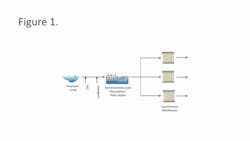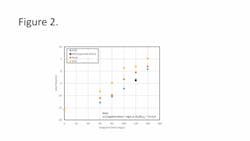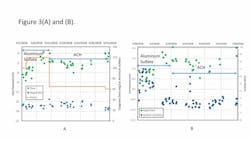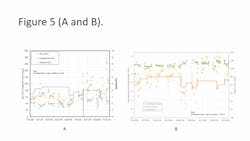Zeta Potential for Ultrafiltration & Microfiltration Membranes
About the author:
Greg Pope is an engineer for Carollo Engineers. Pope can be reached at [email protected] or 512.453.5383.
CONTRIBUTING WRITERS
Carol Serna from Carollo Engineers; Sarah Stewart, Alex Doody and Danny Shannon from CDM Smith; and Andrea Brinkley, Robert Upton and Skipper Jones from the city of Pearland, Texas, contributed to this article.
The city of Pearland, Texas, is planning to construct a 10 million gal per day (mgd) membrane-based surface water treatment plant (SWP). The source water for this SWP is the American Canal, which is fed by the Brazos River and natural drainage from the Oyster Creek watershed. This source water is challenging to treat due to the high variability in quality. The raw water turbidity can range from less than 10 NTU to greater than 300 NTU and the total organic carbon (TOC) can range from approximately 3 mg/L up to greater than 7 mg/L. The city, Carollo Engineers Inc. and CDM Smith conducted a nine month pilot study of the proposed treatment train to develop process design criteria based on a representative range of water quality.
Picking the Pilot Processes
Several methods were chosen for the pilot testing process to standardize the tests.
First was pre-oxidation and disinfection with chlorine dioxide. Chlorine dioxide was dosed to the raw water during the pilot study with an Evoqua Millennium III AC-50 generator.
Another was conventional pretreatment and settling with three-stage flocculation and plate settlers. A demonstration-scale flocculation and sedimentation treatment pilot unit was provided by Meurer Research, Inc. (MRI) and was operated at approximately 0.3 gal per minute per sq ft of the projected plate area.
Thirdly, was membrane filtration with three different microfiltration (MF) and ultrafiltration (UF) membranes tested in parallel. The membranes tested included Pall Microza UNA 620A, Toray HFU-2020, and Evoqua L40N.
And lastly, was a system with GAC adsorption for taste and odor control. Two filter columns were operated at 10-minute empty bed contact times with Calgon F400 and Norit 820 GAC. Figure 1 on page 39 shows the treatment train evaluated during the pilot study.
Pretreatment Optimization
The first step in the treatment process is sedimentation. Sedimentation is a solids removal process that relies on the formation of dense particulate agglomerations (floc) by addition of a chemical coagulant. Coagulants work by neutralizing negatively charged particles resulting in the desired agglomerations. Proper dosing of coagulant results in significant solids removal and improved downstream filter performance. Proper coagulation also removes organic carbon and limits the formation of regulated disinfection byproducts.
Traditionally, coagulant doses are selected by performing jar tests. In jar testing, coagulants are added to 2-liter water samples, mixed to simulate rapid mix and flocculation conditions, and settling characteristics are observed. Performance is largely judged by turbidity or clarity of the water after a specified settling time. Jar testing is a proven method for pretreatment optimization, but results take hours to obtain, must be interpreted by the analyst, and there are no clear guidelines for selecting the optimal dose.
Zeta potential is a measure of the magnitude of the electrostatic or charge repulsion and attraction between particles and is one of the fundamental parameters known to affect flocculation (and thus settled water quality). Zeta potential measurements can be made in a matter of minutes compared to the hours required for jar testing, allowing for a rapid response to shifts in raw water quality.
During the pilot testing, coagulant dose was optimized initially by running jar tests, then refining pilot-scale. This approach was problematic because the large shifts in source water quality often lead to either under or overfeeding coagulant, both of which can adversely affect settled water quality and membrane performance (e.g., fouling). The zeta potential of the coagulated water, measured twice each day in the raw, rapid mix and settled water, also was used to optimize the pretreatment process. Of the optimization approaches tested, zeta potential measurements proved to be the best, most rapid optimization tool used at the pilot.
Zeta potential also was used to compare different coagulants. The impact of coagulant type and dose on zeta potential was first tested bench scale. Results are are shown in Figure 2. In this figure, each coagulant dose is shown in mg/L as Al2(SO4)3*14H₂O. Based on this analysis, lower doses of ACH were required to achieve the same zeta potential as either PACl or aluminum sulfate. Similar results were observed pilot scale. Figure 3A and B show the impact of switching coagulants from aluminum sulfate to ACH on settled water quality of the pilot pretreatment system. During the period of alum coagulation, operation at a zeta potential between -4 and -2 resulted in lower settled water turbidity than operation at a zeta potential between -6 and -8. Upon switching to ACH, lower doses were required to maintain the same zeta potential and settled water turbidity. A summary of coagulant performance is shown in Table 1.
The impact of switching coagulants on membrane performance is shown in Figure 4. No impact on membrane hydraulic performance was observed, likely a result of maintaining a consistent zeta potential of the water applied to the MF systems. Maintaining the “right” zeta potential also resulted in good settled water turbidity, consistent organics removal, and stable membrane performance.
The raw and settled water turbidity during the pilot test period are shown in Figure 5A (page 40). Corresponding zeta potential is shown in Figure 5B (page 40). Clear guidelines could be established to target a range of zeta potential in the pilot system. During the testing, it was determined that changing the coagulant dose to keep the zeta potential in the range of -2 mV and +2 mV resulted in consistent settled water quality even during rapid shifts in source quality.
Raw water turbidity could change significantly in a matter of hours (e.g. approximately double from 50 NTU to 100 NTU in an eight hour period). Monitoring zeta potential allowed pilot operators to respond quickly to source water quality changes by adjusting the coagulant dose.
There also is a correlation between zeta potential and TOC removal. Operation at a zeta potential (of the rapid mix) between 0 and +2 resulted in greater TOC removal than operation between -4 and -2 but did not significantly impact settled water turbidity when compared to operating at a zeta potential of approximately -2.
Summary
Zeta potential was a rapid and effective tool for optimization of the coagulation process. This tool was more accurate and rapid than conventional approaches, such as jar testing, and allowed clear guidelines to be established for treatment. The range of zeta potential that produced low fouling conditions for the membrane systems is a directly measurable, scalable parameter. Available online devices also can provide continuous feedback and allow operators to adjust doses in response to the rapid water quality changes.
Through experiences at Pearland and other utilities that are using zeta potential for pretreatment optimization, the correct zeta target is utility specific. Differences in source water, pretreatment strategy and coagulant type can all influence the target zeta. Regardless, its use can optimize pretreatment, potentially leading to savings in coagulant and polymer use. It also can limit potential for fouling MF and UF membranes from either under or over feeding coagulant.





